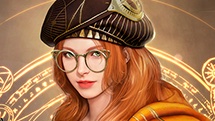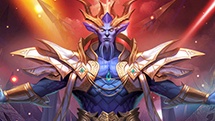Many gamers who play Massively Multiplayer Online Role-Playing Games (MMORPGs) may have not heard of Hak Kyu Kim, but they may have heard of Ragnarok Online. Hak Kyu Kim left Gravity Co., Ltd. to make a new MMORPG under the corporation IMC Games Co., Ltd. Sword of the New World: Granado Espada is a unique game that whether or not one wants to dungeon crawl, do some quests, or customize the battling style of their “teams”, that player surely will be interested.
The game starts with a Baroque music piece on the server selection screen. One of the appealing features of the game includes the combination of classical Baroque music combined with modern techno and trance music. While the music transitions to different places, each change fits well. For example, a town setting has a relaxed Baroque piece while a field/dungeon map has an upbeat trance or techno piece that motivates the player to fight.
When creating a character, you notice that there are five characters to choose from, Fighter, Scout, Wizard, Elementalist, and Musketeer. The clothing is fixed despite an option to originally change clothing at the creation menu. There are other methods of getting more classes; there was a quest that gave one character, a Reboldoeux Soldier card through a quest, which permits the creation of that class only once.
While in the character creation menu, what you notice is that you can start with a team at a certain location. But, what is a team? The main feature of this game is the Multiple Character Control system, or the MCC. What this feature means is that you make your own “mini-party,” and you actually control it. If this sounds confusing, the Non-player characters or NPCs in the game actually explain how to move and fight with the MCC.
Initially starting Sword of the New World has some bugs. After getting off the ship, the quests, purposely explaining how the User Interface works, are rather misguiding. It seems some NPCs had not been renamed after the new patch updated the game. Though this may be not a hassle if one has played the game before, new players may face conflicts.
The game does explain the battle system very well through a select amount of NPCs. There are five types of attack systems, point and click, assault, harvest, hold, and defend, and two types of formation commands, team summon and team select. Each command of movement and attack has its own strategic value. For example, point and click is best bringing down a single boss monster or luring the monsters into an Area of Effect (AoE) skill.
The graphics are very vivid. Bright colors of realistic buildings and landscape are filled with lavish details. This can be seen when walking in outside environment. In the dungeon, although still detailed, there are instances when the textures are used repeatedly; however, this does not take away from playability, since the enemies are always swarming in with massive amounts.
The game plays in various ways. While this game is mainly point and click, this game has countless strategic value in the combat system. To illustrate, should the player want to kill the stronger enemy with a point or click while getting beat down by the lesser enemies? Should the player want to use defend mode and attack all the enemies? On the other hand, should the player use an AoE skill and then concentrate on the stronger enemy? These questions that are being asked constantly battle the player’s mind while playing the game. A big forefront in strategy is played in Player vs. Player (PvP) matches. In PvP, there are instances where the player has to choose the skills at the right time to dispose or support the party. For example, when I was in one PvP match, I took out the opposing party’s Scout first then their Elementalist, and finally their Musketeer. I attacked in this order because the Scout can heal the whole party, while the Elementalist can hurt the whole party, leaving the Musketeer last since it can only attack far range. To sum up this example, Sword of the New World has traces of Real-time Strategy (RTS).
Another feature of Sword of the New World is “stances.” Stances are the different types of skills build that a character of a certain class can use. They are many different types of stances that can be used, each with different skills, weapons, and ability points/bonuses. The biggest drawback of this feature is that there are some classes that need stances to be unlocked in order to get or acquire some necessary skills, particularly the Musketeer. In particular, it is hard to find which stance the player needs to get due to gameplay error. I found myself having a “confusion attack,” wondering where I can find these skill books. Well after a Google search, I found out those stances were NPC only, wondering why the creators of the game would allow the players to be confused? Another problem with the stances is that some stances require more money than other stances do. The magic casting characters, the Wizards and the Elementalists, need more money for certain stances because they require some items that are used for skills.
In the initial stages of traveling, there is not much need for potions, since all the weaker monsters drop instant health consumables to heal the party. However, as the levels go higher, the biggest limitation I felt while traveling in Sword of the New World is that I always have to carry a Scout. Because the game AI always sends enemies to amass my party, I often die, unless a Scout is present. Even if one carries potions or takes the health consumable, Scouts are indispensable to the party. This problem carries on throughout the game, such as trying to train characters and a vital party member is not used.
There is not much of a community in Sword of the New World. Since the majority of the lower levels are busy grinding, while the higher levels are having clan wars, taking colonies, or PvPing, the player might feel rather lonely unless the player brings some friends to play. As for the quality of the community, there was only one instance when I refused to join one’s clan, that player took only character, who was over-leveled, and killed all of my players.
The last complaint that I hold is that the game does not explain some of the NPCs or game functions. Until my friend told me, I did not know about a Jukebox function, which switches up the music of the game according to the area you are located. The most important matter, the auction house function was not known until that same friend scolded me for selling an item that was worth millions. These examples can demonstrate that, unless a casual player does not know the whereabouts and the functions of the NPCs, the player may have a hard time playing the actual game.
Overall, the game is a standstill between good or bad. Personally, I found this game to be pleasant at points, but unmemorable at other points. However, for something completely different, Sword of the New World does a great job by putting new features in an MMORPG.



